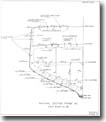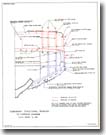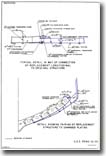












If you can see this text here you should update to a newer web browser
Normal | Highlight & Comment Highlighted Text will be in Yellow, but there are none yet
|
RESTRICTED
1. A submarine torpedo detonated at about frame 92, port, in way of shell strake "C", and caused serious local damage. Shell plating and supporting structure was ruptured between frames 88 and 97, a distance of about 33 feet, and from "B" strake to "F" strake, a distance of about 22 feet. Damage to adjacent plating extended between frames 84 and 103 and from "A" strake to the main deck. The main, 2nd and lst platform decks were destroyed between frames 88 and 97, port. This damage as well as that to the main deck and interior structure is shown on Plate 4 and Photos 2 and 3. Extensive flooding resulted in a condition of negative initial stability, however, damage control measures undertaken by the ship's force and ZUNI (ATF 95) enabled the ship to be towed 700 miles to Ulithi. Despite the marked loss of strength at frame 93, port, no progressive structural failures were noted during this passage in heavy weather. 2. No drydoaking facilities were available at Ulithi. Temporary repairs were undertaken by VESTAL (AR 4) and RENO with the aim of making the best possible improvement in stability, watertight integrity, and longitudinal, transverse and local strength. Immediately upon arrival and throughout repairs divers were used to determine the extent of damage, both in the vicinity of the explosion and to the rest of the underwater body and appurtenances. a. Stability During Repairs (Refer to Plate 4).
|
|
RESTRICTED
|
||||||||||||||||||||||||||
|
3. After completion of these repairs, RENO was towed to Manus and drydocked in AHSD 2, where temporary repairs to the underwater body were made by WHITNEY (AD4), Navy Repair Unit 3205 and RENO. The care taken to align replacement members with original structure and to achieve continuity in way of all connections is shown in Plates 7, 8 and Photos 6, 7. Stanchions were installed at frames 90, 92 and 94 1/2 to compensate for the bulkhead which was not replaced at frame 90 and to provide additional stiffness (Photo 8).
|
Transcribed by RESEARCHER @ LARGE. Formatting & Comments Copyright R@L.
Reno Home | Repairs in Forward Areas Home |
Ships Home | Researcher@Large Home